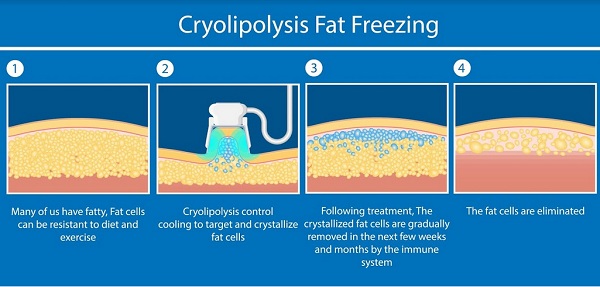Fat freezing, known for its fancier name, cryogenic lipolysis, is perhaps one of the most sought-after non-invasive cosmetic procedures today. And for good reason.
This body sculpting procedure aims to help you get rid of fats without the dreaded needles, anesthesia, and a few weeks of downtime, unlike liposuction. As its name suggests, cryolipolysis involves freezing the fat to destroy them. The idea was said to have been borne out of a research, where one of the findings was that fat cells froze before the skin in the event of a frost bite.
If the thought of freezing fat in your specific problematic areas has crossed your mind, it’s best to make an informed decision by learning more about the procedure. In this article, run through the basics of fat freezing and find facts about cryolipolysis that you ought to know.
-
What Is Fat Freezing?
Cryogenic lipolysis or cryolipolysis, is a fat reduction treatment that involves the use of a cold machine that crystallises and destroys fat cells. It can be done anywhere in your body’s fat-accumulating sections such as thighs, abdomen, and arms.
There are two types of fat that develop in the body: subcutaneous fat which forms under the skin and visceral fat which envelopes the internal organs. Because the body become less efficient in fighting subcutaneous fat with age, cryolipolysis may be a welcome idea in getting rid of batwing arms and sagging beer bellies.
-
How Does Fat Freezing Work?
Fat is apparently more sensitive than the skin when cold temperature is applied on it. Banking on this discovery, the first cryolipolysis machine was created in 2010. It aimed to bust out fats in the belly section. Seeing encouraging results, the machine expanded to treating other areas of the body such as the thighs, chin, and buttocks, among other problem areas.
The cooling machine has a paddle or suction machine that’s placed on any problem area with the aim of freezing and destroying fat cells. Once the fat cells are destroyed, the body’s immune system, particularly the macrophages, dissolve the damaged fat cells.
-
How Does Fat Freezing Differ From Liposuction?
Fat freezing involves the application of cold temperatures to remove accumulated subcutaneous fats found underneath the skin. Liposuction, on the other hand, is a surgical procedure that involves incisions meant to reduce fat by sucking it out from the body. As an invasive procedure, it involves the use of anesthesia, and recovery period from the procedure lasts for about two to three weeks.
But, while cryolipolysis may only be effective after a few sessions, liposuction is performed only once to address fat issues in a specific area of the body.
-
How Many Fat Freezing Sessions Do I Need?
The amount of fat that you need to get rid of and your body’s reaction to the procedure are two of the main factors that determine the number of sessions you need.
Each session may take from thirty minutes to one hour, but multiple applications of the cooling device may be required to cover a certain section, for instance, the belly and love handles.
-
Is Fat Freezing Safe?
Generally speaking, fat freezing is a safe procedure, with minimal side effects. Globally, it’s estimated that more than 8 million fat freezing procedures have been done.
-
What Are The Side Effects And Risks Involved In Fat Freezing?
While there’s virtually no downtime associated with fat freezing, there are minimal risks and side effects involved in cryolipolysis such as:
- Redness
- Minimal bruising
- Swelling
- A tingling sensation
- Darkening of the affected area
- Numbness
It was also reported that less than 1% of the patients may develop increased fat development in the treated area.
Persons with specific health conditions such as Raynaud’s disease, urticaria, nerve issues, inflammatory skin disorders, and eczema are discouraged from undergoing fat freezing.
-
How Long Does It Take For The Results To Show?
Fat freezing could take time, and results may not show until three weeks or for up to three months.
The procedure can remove as much as 30% of the fat cells in the treatment area. However, if the individual needs to get rid of a significant amount of fat, other types of complementary treatment, such as weight loss injections and maintaining a healthy lifestyle, are recommended.
-
Who Should Get The Procedure?
Fat freezing helps with fat loss and not weight loss. Ideal candidates are patients who aren’t obese and only need to get rid of persistent fat that won’t budge in spite of proper diet and exercise.
-
How Much Does Fat Freezing Cost?
Each treatment may cost an average of GBP£424.92, but to achieve the best results, it’s best to prepare GBP£1416.41, as multiple sessions may be required. As a cosmetic procedure, cryolipolysis is not covered by health insurance.
Final Thoughts
With the essential facts discussed earlier, you can arrive at an informed decision about fat freezing. Choose a reputable clinic or a medical professional to perform this procedure so that you won’t have problems down the road.

















